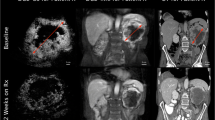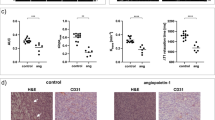Summary
Background: Interstitial hypertension is responsible for poor capillary blood flow and hampered drug delivery. The efficacy of combined sorafenib/bevacizumab treatment given according to different administration schedules has been evaluated by measuring both interstitial pressure (IP) and quantitative dynamic contrast-enhanced ultrasonography (DCE-US) parameters in melanoma-bearing mice. Materiel and Methods: Sixty mice were xenografted with B16F10 melanoma. Animals received a daily administration over 4 days (D0 to D3) of either sorafenib at 30 mg/kg, bevacizumab at 2.5 mg/kg alone, or different schedules of combined treatments. Perfusion parameters determined using an Aplio® sonograph (Toshiba) with SonoVue® contrast agent (Bracco) were compared to IP measurements using fiberoptic probes (Samba®) at D0, D2, D4, D8. Results: The mean baseline IP values ranged between 6.55 and 31.29 mmHg in all the groups. A transient IP decrease occurred at D2 in all treated groups, and especially in the concomitant group which exhibited a significant IP reduction compared to D0. A significant decrease in both the peak intensity and the area under the curve was observed at D4 in the group with concomitant administration of both molecules which yielded maximal inhibition of the tumor volume and the number of vessels. No correlation was found between IP values and volume or perfusion parameters, indicating complex relationships between IP and vascularization. No IP gradients were found between the center and the periphery but IP values in these two regions were significantly correlated (R = 0.93). Conclusion: The results suggest that IP variations could be predictive of vascular changes and that one single IP measurement is sufficient to fully characterize the whole tumor.





Similar content being viewed by others
Abbreviations
- IP:
-
Interstitial Pressure
- DCE-US:
-
Dynamic Contrast-Enhanced Ultrasonography
References
Young JS, Lumsden CE, Stalker AL (1950) The significance of the tissue pressure of normal testicular and of neoplastic (Brown-Pearce carcinoma) tissue in the rabbit. J Pathol Bacteriol 62(3):313–333
Gullino PM, Clark SH, Grantham FH (1964) The interstitial fluid of solid tumors. Cancer Res 24:780–794
Boucher Y, Kirkwood JM, Opacic D, Desantis M, Jain RK (1991) Interstitial hypertension in superficial metastatic melanomas in humans. Cancer Res 51(24):6691–6694
Jain RK (1988) Determinants of tumor blood flow: a review. Cancer Res 48(10):2641–2658
Sevick EM, Jain RK (1989) Geometric resistance to blood flow in solid tumors perfused ex vivo: effects of tumor size and perfusion pressure. Cancer Res 49(13):3506–3512
Heldin CH, Rubin K, Pietras K, Ostman A (2004) High interstitial fluid pressure—an obstacle in cancer therapy. Nat Rev Cancer 4(10):806–813
Jain RK (1987) Transport of molecules in the tumor interstitium: a review. Cancer Res 47(12):3039–3051
Curti BD, Urba WJ, Alvord WG et al (1993) Interstitial pressure of subcutaneous nodules in melanoma and lymphoma patients: changes during treatment. Cancer Res 53(10 Suppl):2204–2207
Milosevic M, Fyles A, Hedley D et al (2001) Interstitial fluid pressure predicts survival in patients with cervix cancer independent of clinical prognostic factors and tumor oxygen measurements. Cancer Res 61(17):6400–6405
Milosevic M, Fyles A, Hedley D, Hill R (2004) The human tumor microenvironment: invasive (needle) measurement of oxygen and interstitial fluid pressure. Semin Radiat Oncol 14(3):249–258
Jain RK (2001) Normalizing tumor vasculature with anti-angiogenic therapy: a new paradigm for combination therapy. Nat Med 7(9):987–989
Jain RK (2005) Normalization of tumor vasculature: an emerging concept in antiangiogenic therapy. Science 307(5706):58–62
Sorensen AG, Patel S, Harmath C et al (2001) Comparison of diameter and perimeter methods for tumor volume calculation. J Clin Oncol 19(2):551–557
Lassau N, Mercier S, Koscielny S et al (1999) Prognostic value of high-frequency sonography and color Doppler sonography for the preoperative assessment of melanomas. AJR Am J Roentgenol 172(2):457–461
Lassau N, Paturel-Asselin C, Guinebretiere JM et al (1999) New hemodynamic approach to angiogenesis: color and pulsed Doppler ultrasonography. Invest Radiol 34(3):194–198
Lavisse S, Lejeune P, Rouffiac V et al (2008) Early quantitative evaluation of a tumor vasculature disruptive agent AVE8062 using dynamic contrast-enhanced ultrasonography. Invest Radiol 43(2):100–111
Elie N, Kaliski A, Peronneau P, Opolon P, Roche A, Lassau N (2007) Methodology for quantifying interactions between perfusion evaluated by DCE-US and hypoxia throughout tumor growth. Ultrasound Med Biol 33(4):549–560
Rouffiac V, Duret JS, Peronneau P et al (2006) Combination of HIFU therapy with contrast-enhanced sonography for quantitative assessment of therapeutic efficiency on tumor grafted mice. Ultrasound Med Biol 32(5):729–740
Wilhelm S, Chien DS (2002) BAY 43-9006: preclinical data. Curr Pharm Des 8(25):2255–2257
Murphy DA, Makonnen S, Lassoued W, Feldman MD, Carter C, Lee WM (2006) Inhibition of tumor endothelial ERK activation, angiogenesis, and tumor growth by sorafenib (BAY43-9006). Am J Pathol 169(5):1875–1885
Ferrara N, Hillan KJ, Novotny W (2005) Bevacizumab (Avastin), a humanized anti-VEGF monoclonal antibody for cancer therapy. Biochem Biophys Res Commun 333(2):328–335
Chang YS, Adnane J, Trail PA et al (2007) Sorafenib (BAY 43-9006) inhibits tumor growth and vascularization and induces tumor apoptosis and hypoxia in RCC xenograft models. Cancer Chemother Pharmacol 59(5):561–574
Liu L, Cao Y, Chen C et al (2006) Sorafenib blocks the RAF/MEK/ERK pathway, inhibits tumor angiogenesis, and induces tumor cell apoptosis in hepatocellular carcinoma model PLC/PRF/5. Cancer Res 66(24):11851–11858
Wilhelm SM, Carter C, Tang L et al (2004) BAY 43-9006 exhibits broad spectrum oral antitumor activity and targets the RAF/MEK/ERK pathway and receptor tyrosine kinases involved in tumor progression and angiogenesis. Cancer Res 64(19):7099–7109
Escudier B, Eisen T, Stadler WM et al (2007) Sorafenib in advanced clear-cell renal-cell carcinoma. N Engl J Med 356(2):125–134
Llovet JM, Ricci S, Mazzaferro V et al (2008) Sorafenib in advanced hepatocellular carcinoma. N Engl J Med 359(4):378–390
Kolinsky K, Shen BQ, Zhang YE et al (2009) In vivo activity of novel capecitabine regimens alone and with bevacizumab and oxaliplatin in colorectal cancer xenograft models. Mol Cancer Ther 8(1):75–82
Cusack JC Jr, Liu R, Xia L et al (2006) NPI-0052 enhances tumoricidal response to conventional cancer therapy in a colon cancer model. Clin Cancer Res 12(22):6758–6764
Segerstrom L, Fuchs D, Backman U, Holmquist K, Christofferson R, Azarbayjani F (2006) The anti-VEGF antibody bevacizumab potently reduces the growth rate of high-risk neuroblastoma xenografts. Pediatr Res 60(5):576–581
Azad NS, Posadas EM, Kwitkowski VE et al (2008) Combination targeted therapy with sorafenib and bevacizumab results in enhanced toxicity and antitumor activity. J Clin Oncol 26(22):3709–3714
Feldman DR, Baum MS, Ginsberg MS et al (2009) Phase I trial of bevacizumab plus escalated doses of sunitinib in patients with metastatic renal cell carcinoma. J Clin Oncol 27(9):1432–1439
Lassau N, Chami L, Benatsou B, Peronneau P, Roche A (2007) Dynamic contrast-enhanced ultrasonography (DCE-US) with quantification of tumor perfusion: a new diagnostic tool to evaluate the early effects of antiangiogenic treatment. Eur Radiol 17(Suppl 6):F89–F98
Miller DL, Dou C, Wiggins RC (2007) Doppler mode pulse sequences mitigate glomerular capillary hemorrhage in contrast-aided diagnostic ultrasound of rat kidney. IEEE Trans Ultrason Ferroelectr Freq Control 54(9):1802–1810
Hagendoorn J, Tong R, Fukumura D et al (2006) Onset of abnormal blood and lymphatic vessel function and interstitial hypertension in early stages of carcinogenesis. Cancer Res 66(7):3360–3364
Dickson PV, Hamner JB, Sims TL et al (2007) Bevacizumab-induced transient remodeling of the vasculature in neuroblastoma xenografts results in improved delivery and efficacy of systemically administered chemotherapy. Clin Cancer Res 13(13):3942–3950
Jain RK (2003) Molecular regulation of vessel maturation. Nat Med 9(6):685–693
Tong RT, Boucher Y, Kozin SV, Winkler F, Hicklin DJ, Jain RK (2004) Vascular normalization by vascular endothelial growth factor receptor 2 blockade induces a pressure gradient across the vasculature and improves drug penetration in tumors. Cancer Res 64(11):3731–3736
Gerber HP, Ferrara N (2005) Pharmacology and pharmacodynamics of bevacizumab as monotherapy or in combination with cytotoxic therapy in preclinical studies. Cancer Res 65(3):671–680
Jain RK, Duda DG, Clark JW, Loeffler JS (2006) Lessons from phase III clinical trials on anti-VEGF therapy for cancer. Nat Clin Pract Oncol 3(1):24–40
Soria JC, Sessa C, Perotti A, et al. (2008) A comprehensive study of translational research and safety exploration of the vascular disrupting agent (VDA) AVE8062 in combination with cisplatin administered every 3 weeks to patients with advanced solid tumors. AACR Meeting Abstracts, Apr 2008; LB-302 2008
Fadnes HO, Reed RK, Aukland K (1977) Interstitial fluid pressure in rats measured with a modified wick technique. Microvasc Res 14(1):27–36
Scholander PF, Hargens AR, Miller SL (1968) Negative pressure in the interstitial fluid of animals. Fluid tensions are spectacular in plants; in animals they are elusively small, but just as vital. Science 161(839):321–328
Wiederhielm CA, Woodbury JW, Kirk S, Rushmer RF (1964) Pulsatile pressures in the microcirculation of frog’s mesentery. Am J Physiol 207:173–176
Rofstad EK, Tunheim SH, Mathiesen B et al (2002) Pulmonary and lymph node metastasis is associated with primary tumor interstitial fluid pressure in human melanoma xenografts. Cancer Res 62(3):661–664
Ozerdem U (2009) Measuring interstitial fluid pressure with fiberoptic pressure transducers. Microvasc Res 77(2):226–229
Gutmann R, Leunig M, Feyh J et al (1992) Interstitial hypertension in head and neck tumors in patients: correlation with tumor size. Cancer Res 52(7):1993–1995
Jain RK, Baxter LT (1988) Mechanisms of heterogenous distribution of monoclonal antibodies and other macromolecules in tumors: significance of elevated interstitial pressure. Cancer Res 48:7022–7032
Boucher Y, Baxter LT, Jain RK (1990) Interstitial pressure gradients in tissue-isolated and subcutaneous tumors: implications for therapy. Cancer Res 50(15):4478–4484
Author information
Authors and Affiliations
Corresponding author
Rights and permissions
About this article
Cite this article
Leguerney, I., Lassau, N., Koscielny, S. et al. Combining functional imaging and interstitial pressure measurements to evaluate two anti-angiogenic treatments. Invest New Drugs 30, 144–156 (2012). https://doi.org/10.1007/s10637-010-9543-y
Received:
Accepted:
Published:
Issue Date:
DOI: https://doi.org/10.1007/s10637-010-9543-y




